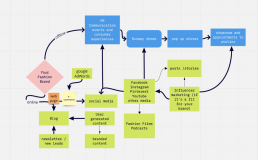The offline and online worlds offer endless opportunities to connect with a consumer who is hyper-informed and hyper-connected, and while none of these environments will disappear or become stronger than the other, they will coexist. This is why the work of marketers is becoming increasingly complicated, but if you do it well, you will achieve a group of loyal followers. So it’s time to reorient your strategy and get creative to expand your horizons combining the best of both worlds.
When it comes to engaging with your customers you have to keep in mind, what activities are they involved in, and the response towards the brand or product you are selling; what makes the concept of your brand different from other brands; what are the most popular touchpoints between you and your client; above all, the key is to experiment and evaluate.
Here are a few strategies you can implement to generate engagement

Product experiences: These can be offline and online. It will depend on the most relevant touchpoints, and that you correctly guide the user through the DNA of your brand, with this, you can even get purchases.
Offline: PR events that could include launching a product or having a special experience like a brunch with influencers to introduce a new line of products.
Online: For example, newsletters in order to keep data and leads, but also inform them of new products, collections, and special offers. Create an online activity where they can be part of the brand, maybe a quiz, or a customized game.
Collaboration: You can have a brand ambassador, or do a partnership with other brands. Expand the audience and connect with values related to the brand.
Storytelling: This is an excellent way to engage with your customer. Storytelling is a way to communicate the brand’s DNA through different media. For example, fashion films. When it comes to storytelling, we can talk about the heritage of luxury brands.
Podcast or Playlists: Nowadays living during the pandemic, most people tend to listen to playlists or podcasts online. It’s a good strategy to reach and engage with your audience. Generate conversations with content.
Paid Advertisement on Social Media: You can implement paid advertising on Facebook and Instagram by doing a detailed segmentation of your customer. On Instagram for example you can do posts, reels, lives, stories, there is a lot of branded material to use to engage with your customer.
Content Marketing: This is a great strategy to gain engagement with your customer. Your brand can have organic content for example a blog, or branded content In collaboration or partnership with other media. For example, an article in a magazine mentioning your product.
Pop-up Stores: These are ephemeral temporary spaces. It’s a good strategy, especially when it comes to launching a special edition, collection, or product. You can choose a place where your ideal customer is familiar. For example, Gucci’s Collaboration with North Face, the pop-up store was only available for certain countries.
Customer Experiences: Sephora is one good example. They do not only offer beauty products, but people also get to have special buying treatment experiences according to the customer’s needs.
Trunk Shows: A trunk shop is a space of right curatorship of brands, they are a good way to engage with a special customer or buyer.
Virtual Fashion Shows: Before and during the pandemic the experience of fashion weeks and events have changed their dynamics. The audience and customers are having a different approach to the brand, and become part of a happening and the experience becomes more inclusive to the people and customers.
Influencer Marketing: This is a good strategy for a brand to engage with a customer when the influencer is a great fit. They might become a brand ambassador, or work in a brand collaboration, for example, an influencer collaboration with a jewelry brand, or be part of brand activation. The influencer must be active online or offline. They don’t need to be macro-influencers necessarily, they can be Nano or micro. Nowadays agencies measure their activities. It could be the number of followers, type of content, and engagement with their audience.
These strategies can help you measure, and integrate offline and online channels in order to engage your customer. Finally, they can generate a great impact on the buyer’s journey, providing the customers with new experiences.
Do you want to learn more about this topic? Find more in the How to Create a Brand program.
